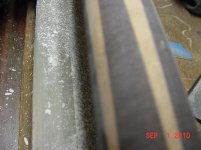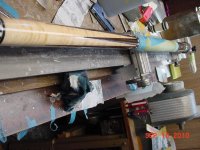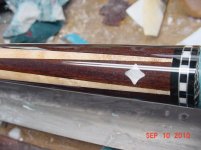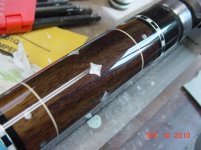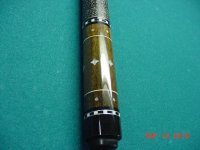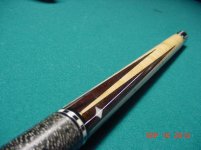All great advice.
I will add that the wood itself may be holding solvent and/or affecting drying rates.
Apply
very thin coats-
anorexic thin.
Allow to tack (as Tony said) each (and every) coat.
Air should be clean and dry (which you know from painting steel)
Since the scale is so much smaller than a car, a great car paint job looks like total GASH on a cue. It MUST be as perfect as you can get it, because cues are 'inspected' 3 inches from the end of the nose.

Most important piece of advice:
DON'T RUSH anything.
Make sure the wood is good and stable- don't 'go for clear' the same day you did your final sanding. I like to wait several days. If you think it may absorb water and/or move on you, you need more stable wood (or better climate control in your shop!)
The wood can absorb solvents (pull them from the clear) and then release them later. Finishing wood is tricky for sure! When I was doing solid colors on guitars I had a very convoluted system in place, but it worked. Otherwise the paint would 'shrink back' and show the wood grain.
Hardener should be 'fresh' (as mentioned) and of the proper temperature range. NEVER push it by using a faster hardener than the actual temperature to finish faster- better to go the
other way and have a
slower cure. It also allows some bonding improvement on wood too (but too slow and you may get sink holes.)
Once you are ready, you may want to seal with cyanoacralate (super glue). I do this some times, but generally it is not needed. Depends on the wood type, inlay complexity and general 'gut feeling' at the time...

I do it more to keep the maple free from (Ebony and other) dust and dirt before I can apply a real clear.
If you apply the clear thin, it will still be ready to block and buff about the same time as if you pour it on in one shot.
I do not sand my clear until I cannot smell it any longer. This can take a while, but usually a week is plenty of time.
Once I block and buff, I DO NOT wax the cue, again until I cannot smell the clear any longer. This can take more than a week easily- usually two or so.
When sanding and buffing, watch the temperature! If the cue is warm to the touch, back off. Let it cool a bit before you go hoggin' at it. Again- DON'T RUSH.
THEN I apply hard wax and call it done.
Another problem you will have at some point is 'sink holes' where clear is absorbed between the inlay or veneer and surrounding wood. In that case, all you can do is take it back (pretty much all the way) and do it again. I had to do this very thing on my John Davis cue I'm finishing up now...
"Perfect or better is all we ask." -typical customer.:wink:

